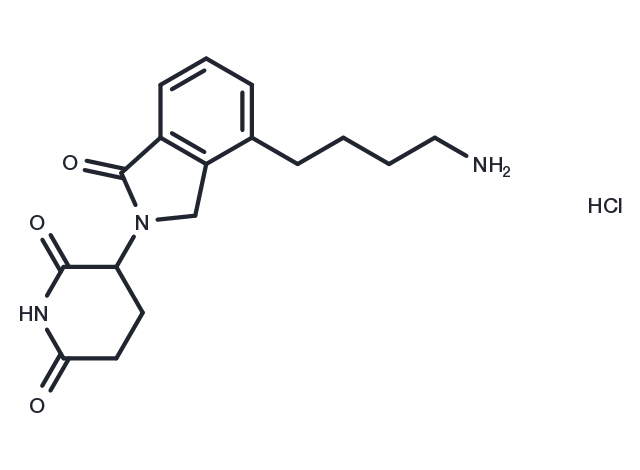Powder: -20°C for 3 years | In solvent: -80°C for 1 year


Lenalidomide-C4-NH2 hydrochloride is a Cereblon ligand derived from Lenalidomide. It serves as a recruiting agent for the CRBN protein. The compound, known as PROTAC (Compound 24), can be formed by linking Lenalidomide-C4-NH2 hydrochloride to the ligand for the protein. It exhibits inhibitory effects with IC50s of 0.98 nM and 13.7 nM against the growth of RS4;11 and MOLM-13 acute leukemia cell lines, respectively[1].

| Pack Size | Availability | Price/USD | Quantity |
|---|---|---|---|
| 2 mg | 5 days | $ 44.00 |
| Description | Lenalidomide-C4-NH2 hydrochloride is a Cereblon ligand derived from Lenalidomide. It serves as a recruiting agent for the CRBN protein. The compound, known as PROTAC (Compound 24), can be formed by linking Lenalidomide-C4-NH2 hydrochloride to the ligand for the protein. It exhibits inhibitory effects with IC50s of 0.98 nM and 13.7 nM against the growth of RS4;11 and MOLM-13 acute leukemia cell lines, respectively[1]. |
| Synonyms | Cereblon ligand 1 hydrochloride, E3 ligase Ligand-Linker Conjugates 32 hydrochloride |
| Molecular Weight | 351.83 |
| Formula | C17H22ClN3O3 |
| CAS No. | T17878 |
Powder: -20°C for 3 years | In solvent: -80°C for 1 year
DMSO: 130 mg/mL (369.50 mM), Sonication is recommended.
You can also refer to dose conversion for different animals. More
bottom
Please see Inhibitor Handling Instructions for more frequently ask questions. Topics include: how to prepare stock solutions, how to store products, and cautions on cell-based assays & animal experiments, etc.
Lenalidomide-C4-NH2 hydrochloride T17878 Others Lenalidomide C4 NH2 hydrochloride Cereblon ligand 1 hydrochloride Lenalidomide-C-4-NH2 hydrochloride E3 ligase Ligand-Linker Conjugates 32 hydrochloride Cereblon ligand 1 Hydrochloride LenalidomideC4NH2 hydrochloride Lenalidomide-C4-NH2 Hydrochloride inhibitor inhibit
